Chrysler 300c Srt8 2006 Owner's Manual

SECTION
TABLE OF CONTENTS
PAGE
1
2
3
4
5
6
7
8
9
10
. . . . . . . . . . . . . . . . . . . . . . . . . . . . . . . . . . . . . . . . . . . . . . . . . . . . . . . . . . .INTRODUCTION |
. . 3 |
1 |
|
|
|
THINGS TO KNOW BEFORE STARTING YOUR VEHICLE . . . . . . . . . . . . . . . . . . . . . . . . . |
. . 9 |
2 |
|
|
|
UNDERSTANDING THE FEATURES OF YOUR VEHICLE . . . . . . . . . . . . . . . . . . . . . . . . . . . |
. 59 |
3 |
|
|
|
UNDERSTANDING YOUR INSTRUMENT PANEL . . . . . . . . . . . . . . . . . . . . . . . . . . . . . . . . . |
129 |
4 |
|
|
|
STARTING AND OPERATING . . . . . . . . . . . . . . . . . . . . . . . . . . . . . . . . . . . . . . . . . . . . . . . . |
181 |
5 |
|
|
|
WHAT TO DO IN EMERGENCIES . . . . . . . . . . . . . . . . . . . . . . . . . . . . . . . . . . . . . . . . . . . . . |
229 |
6 |
|
|
|
MAINTAINING YOUR VEHICLE . . . . . . . . . . . . . . . . . . . . . . . . . . . . . . . . . . . . . . . . . . . . . . |
241 |
7 |
|
|
|
MAINTENANCE SCHEDULES . . . . . . . . . . . . . . . . . . . . . . . . . . . . . . . . . . . . . . . . . . . . . . . . |
283 |
8 |
|
|
|
IF YOU NEED CONSUMER ASSISTANCE . . . . . . . . . . . . . . . . . . . . . . . . . . . . . . . . . . . . . . . |
299 |
9 |
|
|
|
INDEX . . . . . . . . . . . . . . . . . . . . . . . . . . . . . . . . . . . . . . . . . . . . . . . . . . . . . . . . . . . . . . . . . . . |
307 |
10 |

|
INTRODUCTION |
|
|
|
|
|
|
|
1 |
||
|
|
|
|
|
|
CONTENTS |
|
|
|
|
|
Introduction . . . . . . . . . . . . . . . . . . |
. . . . . . . . . 4 |
Vehicle Identification Number . . . . . . . . . . . . . . |
6 |
|
|
How To Use This Manual . . . . . . . . |
. . . . . . . . . 4 |
Vehicle Modifications / Alterations . . . . . . . . . . |
7 |
|
|
Warnings And Cautions . . . . . . . . . |
. . . . . . . . . 6 |
|
|
|
|

4 INTRODUCTION
INTRODUCTION
This manual has been prepared with the assistance of service and engineering specialists to acquaint you with the operation and maintenance of your new vehicle. It is supplemented by a Warranty Information Booklet and various customer oriented documents. You are urged to read these publications carefully. Following the instructions and recommendations in this manual will help assure safe and enjoyable operation of your vehicle.
NOTE: After you read the manual, it should be stored in the vehicle for convenient reference and remain with the vehicle when sold, so that the new owner will be aware of all safety warnings.
When it comes to service, remember that your dealer knows your vehicle best, has the factory-trained technicians and genuine Mopar parts, and is interested in your satisfaction.
WARNING!
Engine exhaust, some of its constituents, and certain vehicle components contain or emit chemicals known to the State of California to cause cancer and birth defects or other reproductive harm. In addition, certain fluids contained in vehicles and certain products of component wear contain or emit chemicals known to the State of California to cause cancer and birth defects or other reproductive harm.
HOW TO USE THIS MANUAL
Consult the table of contents to determine which section contains the information you desire.
The detailed index, at the rear of this manual, contains a complete listing of all subjects.
Consult the following table for a description of the symbols that may be used on your vehicle or throughout this owner’s manual:
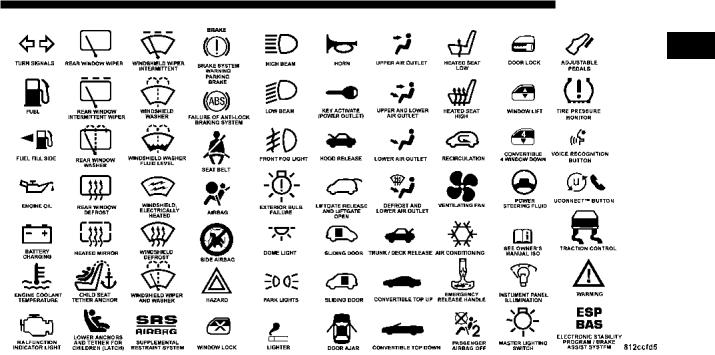
INTRODUCTION 5
1

6 INTRODUCTION
WARNINGS AND CAUTIONS
This manual contains WARNINGS against operating procedures which could result in an accident or bodily injury. It also contains CAUTIONS against procedures which could result in damage to your vehicle. If you do not read this entire manual you may miss important information. Observe all Warnings and Cautions.
VEHICLE IDENTIFICATION NUMBER
The vehicle identification number (VIN) is located near the left front corner of the windshield. The VIN is visible from outside of the vehicle through the windshield. This
number also appears on the Automobile Information VIN LOCATION
Disclosure Label affixed to a window on your vehicle. NOTE: It is illegal to remove the VIN plate. Save this label for a convenient record of your vehicle
identification number and optional equipment.

VEHICLE MODIFICATIONS / ALTERATIONS
WARNING!
Any modifications or alterations to this vehicle could seriously affect its roadworthiness and safety and may lead to an accident resulting in serious injury or death.
INTRODUCTION 7
1

THINGS TO KNOW BEFORE STARTING YOUR VEHICLE
2
CONTENTS
A Word About Your Keys . . . . . . . . . . . . . . . . . |
11 |
▫ Ignition Key Removal . . . . . . . . . . . . . . . . . . . |
11 |
▫ Key-In-Ignition Reminder . . . . . . . . . . . . . . . . |
12 |
▫ Horn . . . . . . . . . . . . . . . . . . . . . . . . . . . . . . . |
12 |
Sentry Key . . . . . . . . . . . . . . . . . . . . . . . . . . . . |
12 |
▫ Replacement Keys . . . . . . . . . . . . . . . . . . . . . . |
13 |
▫ Customer Key Programming . . . . . . . . . . . . . . |
14 |
▫ General Information . . . . . . . . . . . . . . . . . . . . |
15 |
Illuminated Entry System . . . . . . . . . . . . . . . . . |
15 |
Door Locks . . . . . . . . . . . . . . . . . . . . . . . . . . . |
15 |
▫ Manual Door Locks . . . . . . . . . . . . . . . . . . . . . |
15 |
▫ Power Door Locks . . . . . . . . . . . . . . . . . . . . . |
16 |
▫ Child Protection Door Lock . . . . . . . . . . . . . . . |
17 |
Remote Keyless Entry . . . . . . . . . . . . . . . . . . . . |
18 |
▫ To Unlock The Doors . . . . . . . . . . . . . . . . . . . |
19 |
▫ To Lock The Doors . . . . . . . . . . . . . . . . . . . . . |
19 |
▫ To Unlock The Trunk . . . . . . . . . . . . . . . . . . . . |
19 |
▫ Using The Panic Alarm . . . . . . . . . . . . . . . . . . |
20 |
▫ General Information . . . . . . . . . . . . . . . . . . . . |
20 |
▫ Transmitter Battery Service . . . . . . . . . . . . . . . |
21 |
Vehicle Theft Alarm — If Equipped . . . . . . . . . . |
21 |
Windows . . . . . . . . . . . . . . . . . . . . . . . . . . . . . |
23 |

10 THINGS TO KNOW BEFORE STARTING YOUR VEHICLE
▫ Power Windows . . . . . . . . . . . . . . . . . . . . . . . |
23 |
Trunk Lock And Release . . . . . . . . . . . . . . . . . . |
25 |
Trunk Safety Warning . . . . . . . . . . . . . . . . . . . . |
26 |
▫ Trunk Emergency Release . . . . . . . . . . . . . . . . |
27 |
Occupant Restraints . . . . . . . . . . . . . . . . . . . . . |
27 |
▫ Lap/Shoulder Belts . . . . . . . . . . . . . . . . . . . . . |
28 |
▫ Seat Belt Pretensioners . . . . . . . . . . . . . . . . . . . |
32 |
▫ Enhanced Seat Belt Reminder System |
|
(BeltAlert) . . . . . . . . . . . . . . . . . . . . . . . . . . . |
32 |
▫ Seat Belts And Pregnant Women . . . . . . . . . . . . |
33 |
▫ Seat Belt Extender . . . . . . . . . . . . . . . . . . . . . .34
▫ Driver And Right Front Passenger Supplemental Restraint System (SRS) - Airbag . . . . . . . . . . . .35
Engine Break-In Recommendations . . . . . . . . . .56
Safety Tips . . . . . . . . . . . . . . . . . . . . . . . . . . . .56
▫ Exhaust Gas . . . . . . . . . . . . . . . . . . . . . . . . . . |
56 |
▫ Safety Checks You Should Make Inside The |
|
Vehicle . . . . . . . . . . . . . . . . . . . . . . . . . . . . . . |
57 |
▫ Periodic Safety Checks You Should Make |
|
Outside The Vehicle . . . . . . . . . . . . . . . . . . . . |
58 |
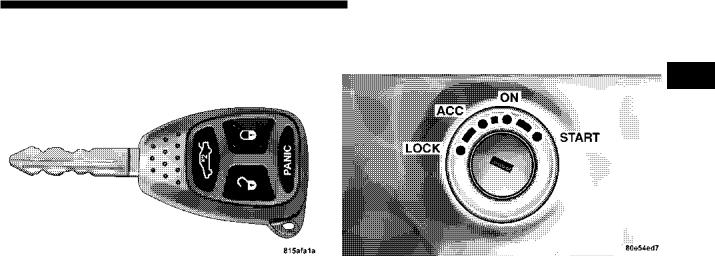
A WORD ABOUT YOUR KEYS
You can insert the double sided keys into the locks with either side up.
Vehicle Key
The dealer that sold you your new vehicle has the key code numbers for your vehicle locks. These numbers can be used to order duplicate keys from your dealer. Ask your dealer for these numbers and keep them in a safe place.
THINGS TO KNOW BEFORE STARTING YOUR VEHICLE 11
Ignition Key Removal
The shift lever must be in PARK. Turn the key to the
LOCK position, then remove the key.
2
Ignition Key Positions
NOTE: The power window switches, radio, power sunroof, and power outlets will remain active for 10 minutes after the ignition switch has been turned off. Opening either front door will cancel this feature. The time is programmable through the electronic vehicle

12 THINGS TO KNOW BEFORE STARTING YOUR VEHICLE
information center (EVIC). Refer to Personal Settings in the Electronic Vehicle Information Center (EVIC) Section for details.
WARNING!
Leaving children in a vehicle unattended is dangerous for a number of reasons. A child or others could be injured. Children should be warned not to touch the parking brake, brake pedal or the gear selector lever. Don’t leave the keys in the ignition. A child could operate power windows, other controls, or move the vehicle.
CAUTION!
An unlocked car is an invitation to thieves. Always remove key from the ignition and lock all doors when leaving the vehicle unattended.
Key-In-Ignition Reminder
If you open the driver’s door and the key is in the ignition switch, a chime will sound to remind you to remove the key.
NOTE: The Key-In-Ignition reminder only occurs when the ignition key is placed in the LOCK or ACC positions.
Horn
Turn the ignition key to the ACC or ON position to operate the horn.
SENTRY KEY
The Sentry Key Immobilizer System prevents unauthorized operation of the vehicle by disabling the engine. The system will shut the engine off after 2 seconds of running if an invalid key is used to start the vehicle. This system utilizes ignition keys which have an electronic chip (transponder) embedded into them. Only keys that have been programmed to the vehicle can be used to start and operate the vehicle.
The Sentry Key Immobilizer System does not need to be armed or activated. Operation of the system is automatic regardless of whether or not the vehicle is locked or

unlocked. During normal operation, the Theft Alarm/ Immobilizer Light will come on for three (3) seconds immediately after the ignition switch is turned on for a bulb check. Afterwards, if the bulb remains on, this indicates a problem with the electronics.
If the bulb begins to flash after the bulb check, this indicates that an invalid key has been used to start the vehicle. Both of these conditions will result in the engine being shut off after two (2) seconds of running.
Keep in mind that a key which has not been programmed is also considered an invalid key even if it is cut to fit the ignition lock cylinder for that vehicle.
If the Theft Alarm/Immobilizer Light comes on during normal vehicle operation (vehicle has been running for longer than 10 seconds), a fault has been detected in the electronics and the vehicle should be serviced as soon as possible.
THINGS TO KNOW BEFORE STARTING YOUR VEHICLE 13
NOTE:
•The Sentry Key Immobilizer System is not compatible
with remote starting systems. Use of these systems may result in vehicle starting problems and loss of 2 security protection.
•Exxon/Mobil Speed Pass,™ additional Sentry Keys, or any other transponder equipped components on the same keychain will not cause a key-related (transponder) fault unless the additional part is physically held against the ignition key being used when starting the vehicle. Cell phones, pagers, or other RF electronics will not cause interference with this system.
All of the keys provided with your new vehicle have been programmed to the vehicle electronics.
Replacement Keys
NOTE: Only keys that have been programmed to the vehicle electronics can be used to start the vehicle. Once a Sentry Key has been programmed to a vehicle, it can not be programmed to any other vehicle.

14 THINGS TO KNOW BEFORE STARTING YOUR VEHICLE
At the time of purchase, the original owner is provided with a four digit PIN number. This number is required for dealer replacement of keys. Duplication of keys may be performed at an authorized dealer or by using the Customer Key Programming procedure. This procedure consists of programming a blank key to the vehicle electronics. A blank key is one which has never been programmed.
NOTE: When having the Sentry Key Immobilizer System serviced, bring all vehicle keys with you to the dealer.
Customer Key Programming
You can program new sentry keys to the system if you have two valid sentry keys by performing the following procedure:
1.Cut the additional Sentry Key Transponder blank(s) to match the ignition switch lock cylinder key code.
2.Insert the first valid key into the ignition switch and turn the ignition switch ON for at least 3 seconds but no longer than 15 seconds. Turn the ignition switch OFF and remove the first key.
3.Insert the second valid key and turn the ignition switch ON within 15 seconds. After ten seconds a chime will sound and the Theft Alarm Light will begin to flash. Turn the ignition switch OFF and remove the second key.
4.Insert a blank Sentry Key into the ignition switch and turn the ignition switch ON within 60 seconds. After 10 seconds a single chime will sound. The Theft Alarm Light will stop flashing, turn on for 3 seconds; then turn off.
The new Sentry Key has been programmed. The Keyless
Entry Transmitter will also be programmed during this procedure.
Repeat this procedure to program up to a total of 8 keys. If you do not have a programmed sentry key, contact your dealer for details.
NOTE: If a programmed key has been lost, see your dealer to have all remaining keys erased from the systems memory. This will prevent the lost key from starting your vehicle. The remaining keys must then be reprogrammed. All vehicle keys must be taken to the dealer at the time of service to be reprogrammed.
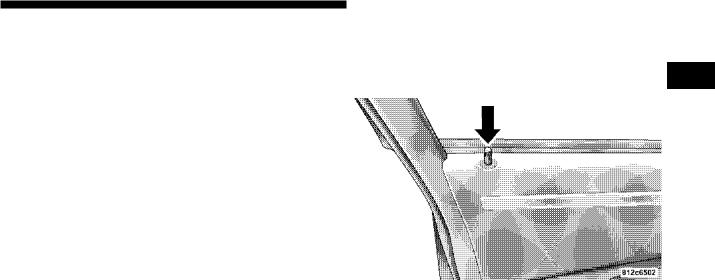
General Information
The Sentry Key system complies with FCC rules part 15 and with RSS-210 of Industry Canada. Operation is subject to the following conditions:
•This device may not cause harmful interference.
•This device must accept any interference that may be received, including interference that may cause undesired operation.
ILLUMINATED ENTRY SYSTEM
The courtesy lights will turn on when you use the keyless entry transmitter or open the doors.
The lights will fade to off after about 30 seconds or they will immediately fade to off once the ignition switch is turned ON from the LOCK position.
NOTE:
•None of the courtesy lights will operate if the dimmer control is in the “defeat” position (extreme downward position).
THINGS TO KNOW BEFORE STARTING YOUR VEHICLE 15
DOOR LOCKS
Manual Door Locks
Lock the doors by pushing down on the door lock 2 plunger on each door trim panel.
Door Lock Plunger
If the door lock plunger is down when you shut the door, the door will lock. Therefore, make sure the keys are not inside the vehicle before closing the door.

16 THINGS TO KNOW BEFORE STARTING YOUR VEHICLE
WARNING!
•For personal security and safety in the event of an accident, lock the vehicle doors as you drive as well as when you park and leave the vehicle.
•When leaving the vehicle always remove the key from the ignition lock, and lock your vehicle. Do not leave children unattended in the vehicle, or with access to an unlocked vehicle. Unsupervised use of vehicle equipment may cause severe personal injuries and death.
Power Door Locks
A power door lock switch is on each front door trim panel. Use this switch to lock or unlock the doors.
Power Door Lock Switch
If you press the power door lock switch while the key is in the ignition, and any front door is open, the power locks will not operate. This prevents you from accidentally locking your keys in the vehicle. Removing the key or closing the door will allow the locks to operate. A chime will sound if the key is in the LOCK or ACC position and a door is open, as a reminder to remove the key.

Automatic Door Locks
The doors will lock automatically on vehicles with power door locks if all of the following conditions are met:
1.The Auto Lock feature is enabled.
2.The transmission is in gear.
3.All doors are closed.
4.The throttle is pressed.
5.The vehicle speed is above 15 mph (24 km/h).
6.The doors were not previously locked using the power door lock switch or remote keyless entry transmitter.
The Automatic Door Lock feature can be enabled or disabled. Refer to “Personal Settings” (Customer Programmable Features) in the Electronic Vehicle Information Center (EVIC) section of this manual for details.
Auto Unlock
The doors will unlock automatically on vehicles with power door locks if:
1. The Auto Unlock feature is enabled.
THINGS TO KNOW BEFORE STARTING YOUR VEHICLE 17
2. The transmission was in gear and the vehicle speed returned to 0 mph (0 km/h).
3. |
The transmission is in NEUTRAL or PARK. |
2 |
|
4. |
The driver door is opened. |
||
|
|||
5. |
The doors were not previously unlocked. |
|
|
6. |
The vehicle speed is 0 mph (0 km/h). |
|
The Auto Unlock feature can be enabled or disabled. Refer to “Personal Settings” (Customer Programmable Features) in the Electronic Vehicle Information Center (EVIC) section of this manual.
NOTE: Use the Auto Door Locks and Auto Unlock features in accordance with local laws.
Child Protection Door Lock
To provide a safer environment for small children riding in the rear seats, the rear doors are equipped with a child protection door lock system.
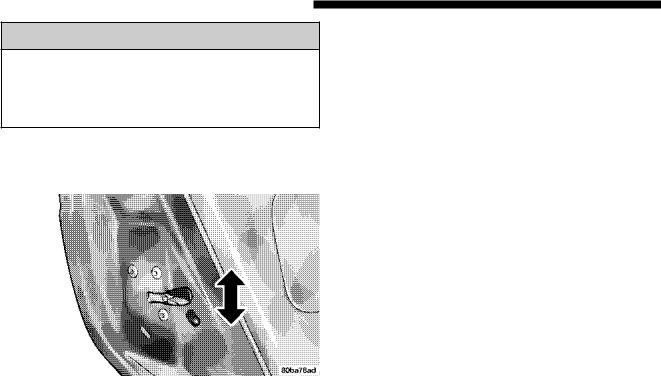
18 THINGS TO KNOW BEFORE STARTING YOUR VEHICLE
WARNING!
Avoid trapping anyone in the vehicle in a collision. Remember that the rear doors can only be opened from the outside when the child protection locks are engaged.
To activate the system, open the rear door and move the child lock control, located near the door’s rear latch, to the ON position.
When the child lock system is engaged the door can be opened only by using the outside door handle even though the inside door lock is in the unlocked position.
REMOTE KEYLESS ENTRY
This system allows you to lock or unlock the doors, open the trunk, or activate the panic alarm from distances up to about 23 feet (7 meters) using a hand held radio transmitter. The transmitter need not be pointed at the vehicle to activate the system.
NOTE: If the key is in the ignition switch, then all buttons on that transmitter will be disabled. The buttons on the remaining transmitters will work. If the vehicle is shifted out of PARK, all the transmitter buttons are disabled for all keys.
Child Lock Control

Keyless Entry Transmitter
To unlock the doors:
Press and release the UNLOCK button on the transmitter once to unlock the driver’s door, or twice to unlock all doors. The turn signal lights will flash twice to acknowledge the unlock signal. The illuminated entry system also turns on.
The headlights will also activate and remain on for 90 seconds (programmable) when the doors are unlocked using the remote keyless entry transmitter. The time for this feature is programmable. Refer to “Turn Headlamps
THINGS TO KNOW BEFORE STARTING YOUR VEHICLE 19
on with Remote Key Unlock” under “Personal Settings” in the Electronic Vehicle Information Center (EVIC) section of this manual for details.
NOTE: The system can also be programmed to unlock 2 all doors on the first press of the UNLOCK button. Refer
to “Remote Unlock Driver’s Door 1st” under “Personal Settings” in the EVIC section of this manual.
To lock the doors:
Press and release the LOCK button on the transmitter to lock all doors. The turn signal lights will flash once to acknowledge the lock signal. The horn will chirp once to acknowledge the signal. If desired, the “Sound Horn On Lock” feature can be turned on or off. Refer to “Personal Settings” in the “Electronic Vehicle Information Center (EVIC)” section of this manual for details.
To unlock the trunk:
Press the trunk button on the transmitter two times to unlatch the trunk.

20 THINGS TO KNOW BEFORE STARTING YOUR VEHICLE
Using The Panic Alarm:
To turn the panic alarm feature ON or OFF, press and hold the PANIC button on the transmitter for at least one second and release. When the panic alarm is on, the headlights and park lights will flash, the horn will pulse on and off and the interior lights will turn on.
The panic alarm will stay on for 3 minutes unless you turn it off by pressing the PANIC button a second time or if the vehicle speed is 15 mph (24 km/h) or greater.
NOTE:
•The interior lights will turn off when the ignition is switched to the ACC or ON position after the panic alarm is activated. However, the exterior lights and horn will remain on.
•When you turn off the panic alarm by pressing the PANIC button a second time, you may have to be closer to the vehicle due to the radio frequency noises of the system.
To Turn Off “Flash Lights On Lock/Unlock”
NOTE: The Flash Lights On Lock/Unlock feature can be turned on or off. Refer to Personal Settings in the EVIC section of this manual.
General Information
This device complies with part 15 of the FCC rules and RSS 210 of Industry Canada. Operation is subject to the following conditions:
•This device may not cause harmful interference.
•This device must accept any interference received, including interference that may cause undesired operation.
If your Remote Keyless Entry transmitter fails to operate from a normal distance, check for these two conditions.
1.A weak battery in the transmitter. The expected life of the battery is a minimum of three years.
2.Closeness to a radio transmitter such as a radio station tower, airport transmitter, and some mobile or CB radios.
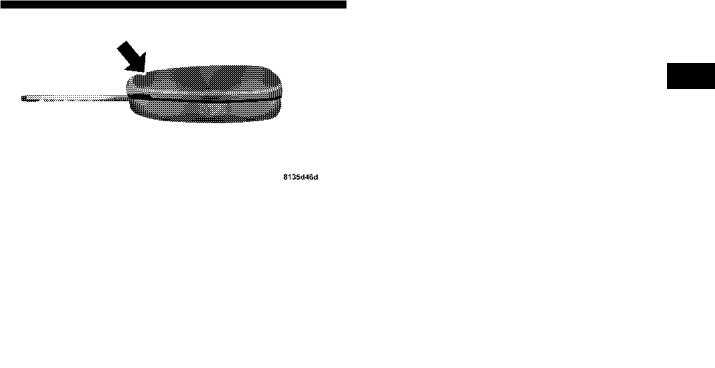
Transmitter Battery Service
The recommended replacement battery is one CR2032 battery.
NOTE: Do not touch the battery terminals that are on the back housing or the printed circuit board.
1. With the transmitter buttons facing down, remove the small screw, and separate the two halves of the transmitter. Make sure not to damage the rubber gasket during removal.
Separating Transmitter Halves
THINGS TO KNOW BEFORE STARTING YOUR VEHICLE 21
2. Remove and replace the battery. Avoid touching the |
|
new battery with your fingers. Skin oils may cause |
|
battery deterioration. If you touch a battery, clean it with |
2 |
rubbing alcohol. |
3. To reassemble the transmitter case, join the two halves of the case together. Install and tighten the screw until snug. Make sure there is an even “gap” between the two halves. Test transmitter operation.
VEHICLE THEFT ALARM — IF EQUIPPED
This system monitors the vehicle doors and ignition switch for unauthorized entry or operation. When the alarm is activated, the system provides both audible and visual signals. The horn will pulse, headlights/park lights will flash, the Vehicle Theft Alarm/Immobilizer light, located on the instrument panel below the Electronic Vehicle Information Center buttons will flash, and the vehicle will not start. If the alarm is triggered and no action is taken to disarm it, the system will turn off the horn after three minutes and after 15 minutes of light only operation the system will then rearm itself.

22 THINGS TO KNOW BEFORE STARTING YOUR VEHICLE
To arm the system: Remove the key from the ignition switch and either:
1.Press a power door lock switch while the driver’s or passenger’s door is open.
2.Press the LOCK button on the keyless entry transmitter.
After the last door is closed, or if all doors are closed, the system will arm itself in about 16 seconds. During that time, the Vehicle Theft Alarm/Immobilizer light will flash. If it does not illuminate, the system is not arming. If you open a door during this arming period, the system will cancel the arming process. You must repeat one of the previously described arming sequences to rearm the system.
To disarm the system: Press the UNLOCK button on the keyless entry transmitter. Also, using a valid sentry key and moving the ignition switch to the ON/START position will disarm the system. If something has triggered the system in your absence, the horn will sound three times when you disarm the system. Check the vehicle for tampering.
NOTE:
•The driver’s door key cylinder and the trunk button on the keyless entry transmitter cannot arm or disarm the system.
•The system remains armed during trunk entry. Pressing the trunk button will not disarm the system. If someone enters the vehicle through the trunk and opens any door the alarm will sound.
•When the system is armed, the doors can not be unlocked from the interior power door lock switches.
The Vehicle Theft Alarm system is designed to protect your vehicle, however, you can create conditions where the system will give you a false alarm. If one of the previously described arming sequences has occurred, the system will arm regardless of whether you are in the vehicle or not. If you remain in the vehicle and open a door, the alarm will sound. If this occurs, disarm the system.
If the alarm system is armed and the battery becomes disconnected the system will remain armed when the
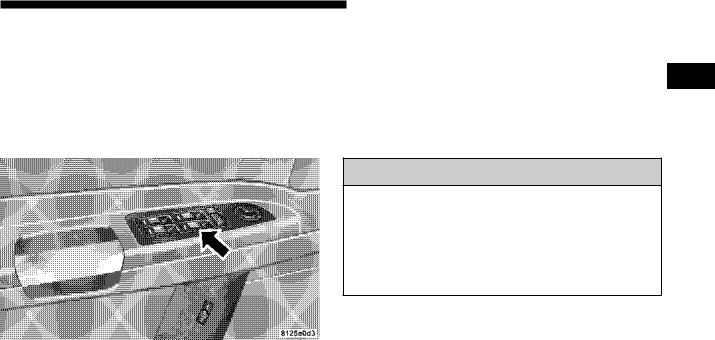
battery is reconnected. The exterior lights will flash, the horn will sound, and the ignition will not start the vehicle. If this occurs, disarm the system.
WINDOWS
Power Windows
The window controls on the driver’s door control all the door windows.
Power Window Switches
There are single window controls on each passenger door trim panel which operate the passenger door windows.
THINGS TO KNOW BEFORE STARTING YOUR VEHICLE 23
The window controls will operate only when the ignition switch is in the ON or ACCESSORY position.
The window lock switch on the driver’s door allows you 2 to disable the window controls on the passenger doors. When the lock switch is pressed the window controls on the passenger doors will not illuminate and the passenger windows will be disabled.
WARNING!
Never leave children in a vehicle, with the keys in the ignition switch. Occupants, particularly unattended children, can become entrapped by the windows while operating the power window switches. Such entrapment may result in serious injury or death.
Auto Down Feature
The driver door power window switch, and some model passenger door power window switches have an auto

24 THINGS TO KNOW BEFORE STARTING YOUR VEHICLE
down feature. Press the window switch to the second detent, release, and the window will go down automatically.
To open the window part way, press the window switch to the first detent and release it when you want the window to stop.
To stop the window from going all the way down during the auto-down operation, pull up on the switch briefly.
The power window switches remain active for 10 minutes after the ignition switch has been turned off. Opening either front door will cancel this feature. The time is customer programmable through the Electronic Vehicle Information Center (EVIC). Refer to “Delay Power Off to Accessories Until Exit” under “Personal Settings” in the Electronic Vehicle Information Center section of this manual for details.
Auto Up Feature with Anti–Pinch Protection—If Equipped
Lift the window switch to the second detent, release, and the window will go up automatically.
To stop the window from going all the way up during the auto-up operation, push down on the switch briefly.
To close the window part way, lift the window switch to the first detent and release when you want the window to stop.
The power window switches remain active for 10 minutes after the ignition switch has been turned off. The time is customer programmable through the electronic vehicle information center (EVIC). Refer to “Delay Power Off to Accessories Until Exit” in the Electronic Vehicle Information Center section for details. Opening either front door will cancel this feature.
NOTE: If the window runs into any obstacle during auto-closure it will reverse direction and then stop. Remove the obstacle and use the window switch again to close the window.
NOTE: Any impact due to rough road conditions may trigger the auto reverse function unexpectedly during auto closure. If this happens pull the switch lightly to the first detent and hold to close window manually.
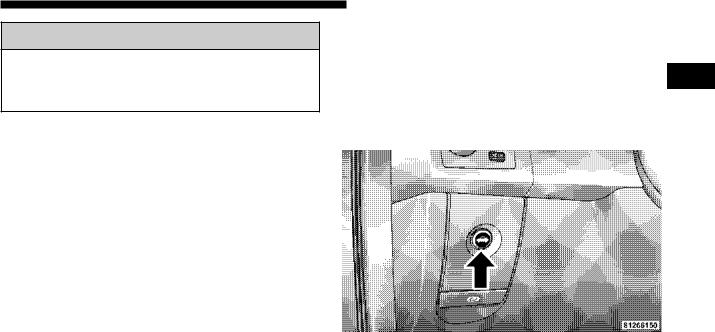
WARNING!
There is no anti-pinch protection when the window is almost closed. Be sure to clear all objects from the window before closing.
Reset
Any time the vehicle battery is disconnected or goes dead the auto-up function will be disabled. To reactivate the auto-up feature perform the following steps after vehicle power is restored:
•Pull the window switch up to close window completely, then hold the switch for a second.
•Push the window switch firmly down to second detent to open the window automatically until the window is fully open.
Wind Buffeting
Wind buffeting can be described as the perception of pressure on the ears or a helicopter type sound in the ears. Your vehicle may exhibit wind buffeting with the windows down, or the sunroof (if equipped) in certain
THINGS TO KNOW BEFORE STARTING YOUR VEHICLE 25
open or partially open positions. This is a normal occurrence and can be minimized. If the buffeting occurs with the rear windows open, open the front and rear windows together to minimize the buffeting. If the buffeting occurs 2 with the sunroof open, adjust the sunroof opening to minimize the buffeting.
TRUNK LOCK AND RELEASE
Trunk Release Button
Press the trunk button on the Remote Keyless Entry Transmitter two times to open the trunk from outside the

26 THINGS TO KNOW BEFORE STARTING YOUR VEHICLE
vehicle. The trunk lid can be released from inside the vehicle by pressing the Trunk Release Button located on the instrument panel to the left of the steering wheel. The transmission must be in Park before the switch will operate.
With the ignition ON, the trunk open symbol will be displayed in the instrument cluster indicating that the trunk is open. The odometer display will reappear once the trunk is closed.
With the key in lock position or key out, the trunk open symbol will be displayed until the trunk is closed.
TRUNK SAFETY WARNING
WARNING!
Do not allow children to have access to the trunk, either by climbing into the trunk from outside, or through the inside of the vehicle. Always close the trunk lid when your vehicle is unattended. Once in the trunk, young children may not be able to escape, even if they entered through the rear seat. If trapped in the trunk, children can die from suffocation or heat stroke.

Trunk Emergency Release
Emergency Release
The trunk of your vehicle is equipped with an emergency release handle. It is located on the inside of the trunk lid, near the latch, and is coated so that it glows in a darkened trunk. Pull on the handle to open the trunk.
THINGS TO KNOW BEFORE STARTING YOUR VEHICLE 27
OCCUPANT RESTRAINTS
Some of the most important safety features in your vehicle are the restraint systems. These include the front and rear seat belts for the driver and all passengers, front 2 airbags for both the driver and front passenger and, if so equipped, left and right side curtain airbags for the driver and passengers seated next to a window. If you will be carrying children too small for adult-size belts, your seat belts also can be used to hold infant and child restraint systems.
Please pay close attention to the information in this section. It tells you how to use your restraint system properly to keep you and your passengers as safe as possible.

28 THINGS TO KNOW BEFORE STARTING YOUR VEHICLE
WARNING!
In a collision, you and your passengers can suffer much greater injuries if you are not properly buckled up. You can strike the interior of your vehicle or other passengers, or you can be thrown out of the vehicle. Always be sure you and others in your vehicle are buckled up properly.
Buckle up even though you are an excellent driver, even on short trips. Someone on the road may be a poor driver and cause a collision which includes you. This can happen far away from home or on your own street.
Research has shown that seat belts save lives, and they can reduce the seriousness of injuries in a collision. Some of the worst injuries happen when people are thrown from the vehicle. Seat belts reduce the possibility of ejection and the risk of injury caused by striking the inside of the vehicle. Everyone in a motor vehicle should be belted at all times.
Lap/Shoulder Belts
All seating positions in your vehicle are equipped with Lap/Shoulder Belts.
The belt webbing retractor is designed to lock during very sudden stops or impacts. This feature allows the shoulder part of the belt to move freely with you under normal conditions. But in a collision, the belt will lock and reduce your risk of striking the inside of the vehicle or being thrown out.
WARNING!
It is extremely dangerous to ride in a cargo area, inside or outside of a vehicle. In a collision, people riding in these areas are more likely to be seriously injured or killed.
Do not allow people to ride in any area of your vehicle that is not equipped with seats and seat belts.
Be sure everyone in your vehicle is in a seat and using a seat belt properly.

WARNING!
•Wearing a seat belt incorrectly is dangerous. Seat belts are designed to go around the large bones of your body. These are the strongest parts of your body and can take the forces of a collision the best. Wearing your belt in the wrong place could make your injuries in a collision much worse. You might suffer internal injuries, or you could even slide out of part of the belt. Follow these instructions to wear your seat belt safely and to keep your passengers safe, too.
•Two people should never be belted into a single seat belt. People belted together can crash into one another in an accident, hurting one another badly. Never use a lap/shoulder belt or a lap belt for more than one person, no matter what their size.
Lap/Shoulder Belt Operating Instructions
1. Enter the vehicle and close the door. Sit back and adjust the front seat.
THINGS TO KNOW BEFORE STARTING YOUR VEHICLE 29
2. The seat belt latch plate is above the back of your seat. |
|
Grasp the latch plate and pull out the belt. Slide the latch |
|
plate up the webbing as far as necessary to make the belt |
2 |
go around your lap. |
Latch Plate To Buckle
3. When the belt is long enough to fit, insert the latch plate into the buckle until you hear a “click.”

30 THINGS TO KNOW BEFORE STARTING YOUR VEHICLE
WARNING!
•A belt that is buckled into the wrong buckle will not protect you properly. The lap portion could ride too high on your body, possibly causing internal injuries. Always buckle your belt into the buckle nearest you.
•A belt that is too loose will not protect you as well. In a sudden stop you could move too far forward, increasing the possibility of injury. Wear your seat belt snugly.
•A belt that is worn under your arm is very dangerous. Your body could strike the inside surfaces of the vehicle in a collision, increasing head and neck injury. A belt worn under the arm can cause internal injuries. Ribs aren’t as strong as shoulder bones. Wear the belt over your shoulder so that your strongest bones will take the force in a collision.
•A shoulder belt placed behind you will not protect you from injury during a collision. You are more likely to hit your head in a collision if you do not wear your shoulder belt. The lap and shoulder belt are meant to be used together.
4. Position the lap belt across your thighs, below your abdomen. To remove slack in the lap belt portion, pull up a bit on the shoulder belt. To loosen the lap belt if it is too tight, tilt the latch plate and pull on the lap belt. A snug belt reduces the risk of sliding under the belt in a collision.
Removing Slack From Belt
